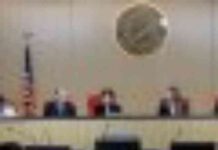(Washington) Inflation slowed sharply again in June in the United States, to 3.0% year on year from 4% the previous month, but it still remains above the Central Bank’s 2% target American (Fed), according to the CPI index published on Wednesday by the Department of Labor.
In June, US inflation thus reached its lowest level since March 2021.
Over one month alone, the rise in consumer prices was 0.2% against 0.1% in May, below analysts’ expectations.
In a statement, US President Joe Biden called the index “encouraging evidence that prices are falling while our economy remains strong.” “Unemployment remains at a record low,” he added.
Also in a slowing phase, core inflation, i.e. excluding food and energy prices, fell to 4.8% year on year, from 5, 3% the previous month.
Here again, the rate observed over one month (0.3%) is slightly lower than expected (0.4%).
Food, which remains a major subject concerning the feeling of the rise in prices, remains on the other hand at a fairly high level (5.7% over one year) but prices have been generally stable in recent months (0.1% in June ).
Another concern, house prices are also experiencing a higher than average pace (7.8% YoY) and seem to remain one of the fixing points for inflation (0.4% YoY) .
More broadly, “underlying services inflation remains high but slightly less than that observed over the past three months and mainly driven by house prices, but should also slow down”, according to Nationwide’s chief economist, Kathy Bostjancic.
This further slowdown in consumer prices has pushed the dollar down to a 16-month low against the euro as traders believe the current pace of inflation opens up the possibility of the Fed making just a rate hike at its next meeting in two weeks.
Wall Street also rejoiced and remained bullish by midday.
Fed Chairman Jerome Powell has repeatedly said in recent weeks that given the state of economic data at the time, several rate hikes were still on the cards, “at least two, possibly in a row,” had -he notably assured during a meeting of central bankers in Sintra (Portugal), at the end of June.
Another member of the Fed’s Monetary Committee (FOMC), Austan Goolsbee, had estimated on July 7 that “the consensus among almost all members is that this year we will have one or two more hikes. I don’t see anything to contradict that.”
However, the Fed has regularly stressed that its next increases will be based on the analysis of macroeconomic data, and in particular the evolution of another inflation index, the PCE, which it favours.
“The Fed has already done a lot: the labor market is showing some signs of easing, inflation is slowing and we are still on the path to a soft landing but the margin is getting tighter and it is going to be difficult for them to continue on this path, “said the chief economist of Oxford Economics, Ryan Sweet, interviewed by AFP.
In May, the PCE index fell to 3.8% but underlying inflation was still too high, especially in services, reinforcing the idea of a hike at the next Fed meeting .
“Underlying PCE inflation remains well above the Fed’s target. The economy remains solid and the rates not so high and especially the main hikes have been made a while ago, so the Fed must do more”, for his part estimated on Twitter Jason Furman, former president of the National Economic Council. and professor at Harvard.
The latest, in mid-June, ended with a first break in the sequence of increases, after ten consecutive rate increases.




